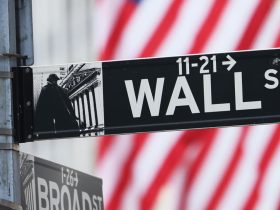Hope for the transformative power of technology has been behind much of the
S&P 500
‘s rally this year. And tech will be key in pushing the index the next 5,000 points higher—and to make stocks worth owning over safer assets, DataTrek Research says.
The tech sector’s Magnificent Seven—namely Apple (ticker: AAPL), Amazon.com (AMZN), Google parent Alphabet (GOOGL), Facebook parent Meta Platforms (META), Microsoft (MSFT), Nvidia (NVDA), and Tesla (TSLA)—have been the main driver for the stock market’s 12.2% gain in 2023. Bulls argue artificial intelligence is only in the early stages of boosting productivity and profit. Consensus earnings estimates for big tech have been climbing, as disrupters reap the benefits of their innovation.
But the market is already pricing in a Goldilocks outcome for the broader economy—one that most strategists wouldn’t have predicted at the start of the year—with continued growth, cooling inflation, and smooth Federal Reserve execution so far. That means it will take something beyond macro factors to propel stocks higher—and to push investors to keep buying stocks when towering bond yields offer stiff competition.
With the 10-year Treasury yielding 4.7%, there’s certainly an argument for owning bonds. Investors might be tempted to go all in on them—or even just to hold cash, given high interest rates—even if they know stocks will likely outperform in the long run.
“A question we frequently get from clients in the current interest rate environment is, ‘Why invest at all?,’” Mark Haefele,
UBS
chief investment officer of Global Wealth Management, wrote in a recent note. “While returns from stocks and bonds may be uncertain over the short term, we expect them to prove durable over the long term…Cash is not an attractive long-term investment.”
But with virtually zero-risk Treasuries sporting elevated yields, the S&P 500 would have to more than double over the next decade—to above 10,000—to compensate investors for the risk of owning equities, DataTrek Research co-found Nicholas
Colas
says.
By adding the 10-year Treasury’s 4.7% yield to the 4.5% equity risk premium (as calculated by New York University’s Aswath Damodaran) for U.S. large-cap stocks, Colas says the lowest annual compounded return that stock investors should accept over the next decade is 9.2%. If the S&P 500 does compound 9.2% annually over the next 10 years, it will reach 10,000 by 2033, Colas wrote Friday.
Of course, that’s a high bar, as Colas notes. S&P 500 companies’ earnings have compounded at an average annual rate of 6.3% over any 10-year period from 1998 to today, with plenty of variability year to year. With earnings—the main driver of stock prices—already near record highs, it seems valuations will also need to expand to bring the index to 10,000. That is where innovation comes in.
In that sense, “productivity-enhancing technology like generative AI cannot come soon enough for U.S. corporate profits,” Colas writes.
That extra push toward 10,000 would likely have to come from tech, he says.
“Since we can’t rely on earnings growth to easily propel U.S. large caps above their required rate of return above risk-free Treasuries, valuations will have to expand in order to achieve that goal,” Colas concludes. “This will come down to seeing a handful of powerfully disruptive and highly profitable companies scale their businesses and, as a result, earn outsized valuations.”
As the Magnificent Seven this year—and Big Tech over the past decade—show, investors really only need a small number of names to power long-term gains, although the more the better.
Capital Economics senior markets economist Thomas Mathews made a similar argument for just how much the stock market needs tech to move significantly higher.
“If there are to be further big gains, we suspect they’ll have to come from something other than continued economic resilience,” he wrote. “One candidate for this is enthusiasm about new technology, such as AI or superconductors, which could plausibly boost equity valuations.”
In other words, even after this year’s rally, tech’s work isn’t done.
Write to Teresa Rivas at [email protected]
Read the full article here













Leave a Reply